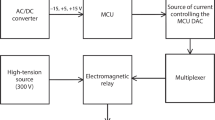Abstract
A new type of synchronous electrophrenic respirator developed by the authors has been applied to dogs with incomplete respiratory failure produced by blocking the 1st thoracic cord and the C6 and C1 branches of both phrenic nerves (sometimes including a unilateral C5 branch). This respirator stimulated the distal stump of the phrenic nerve synchronously with the feeble impulses from the proximal stump of the nerve, resulting in a suitable control of respiration. The minute ventilatory volume and the partial pressures of the expiratory end-tidal gases were adjusted automatically by this respirator, from the state of hypoventilation to the normal control level, accompanied by an overshoot and damped oscillations. The arterial-bloodgases also exhibited a satisfactory recovery from the hypoventilation. The inhalation of high concentrations of carbon dioxide during the synchronous, electrophrenic respiration produced similar responses to those observed in normal dogs. Accordingly, it was found that the synchronous electrophrenic respirator could operate as an element of the respiratory-feedback system.
Sommaire
Un nouveau type de respirateur électrophrénique synchrone, développé par nos soins, a été appliqué à des chiens souffrant d'une défaillance respiratoire incomplète, en bloquant la lère corde thoracique ainsi que les branches C6 et C7 des deux nerfs phréniques (en incluant quelquefois une branche C5 unilatérale). Ce respirateur a stimulé le moignon distal du nerf phrénique en synchronisation avec les impulsions faibles partant du moignon proximal du nerf, permenttant ainsi la régulation convenable de la respiration. Le volume oxygénant minime et les pressions partielles des gaz expirateurs de fin de respiration se trouvaient automatiquement réglés par le respirateur pour passer de l'état d'hypoventilation au niveau normal de la régulation accompagné d'un dépassement et d'oscillations amorties. Les gaz sanguins artériels se sont également rétablis d'une façon satisfaisante. L'aspiration de fortes concentrations d'acide carbonique pendant la respiration électrophrénique synchrone a provoqué des réponses similaires à celles observées pour les chiens normaux. Ainsi on a trouvé que le respirateur électrophrénique synchrone pouvait fonctionner comme élément du système de réaction respiratoire.
Zusammenfassung
Wir entwickelten ein neues synchrones elektrisches Beatmungsgerät für das Zwerchfell, das auf Hunde mit unvollständigem, Atmungsausfall angewandt wurde, der durch eine Blockierung des 1. thorakalen Stranges und der Verzweigungen C6 und C7 von beiden Zwerchfellnerven verursacht worden war (manchmal einschließlich einer einseitigen C5-Abzweigung). Dieses Atemgerät reizte den distalen Stummel des Zwerchfellnerven synchron mit den schwachen Impulsen vom proximalen Stummel des Nervs, so daß sich eine Geeignete Steuerung der Atmung ergab. Das äußerst geringe Beatmungsvolumen und die Teildrücke der ausgeatmenten Gase am Ende des Atemluftvolumens wurden atuomatisch durch dieses Beatmungserät vom Zustand der Unterbeatmung in eine normale Steuerung verwandelt, verbunden mit Übersteuerung und gedämpften Schwingungen. Die Gase des arteriellen Blutes erholten sich hinreichend von der Unterbeatmung. Bei Einatmung von starken Kohlendioxydkonzentrationen während der synchronen elektrischen Zwerchfellbeatmung ergaben sich ähnliche Reaktionen wie auch bei normalen Hunden beobachtet wurden. Auf diese Weise wurde festgestellt, daß das synchrone elektrische Beatmungsgerät für das Zwerchfell als Element der Beatmungsrückkoppelung eingesetzt werden könnte.
Similar content being viewed by others
References
Bilgutay, A. M., Bilgutay, I. M., Garamella, J. J., Jensen, N. K., Schmidt, W. R., Lynch, M. F. andKelly, W. D. (1970) Augmented ventilation by synchronous phrenic nerve stimulation.Trans. Am. Soc. Artif. Int. Organs16, 213–217.
Cross, K. W. andRoberts, P. W. (1951) Asphyxia neonatorum treated by electrical stimulation of the phrenic nerve.Brit. Med. J.4714, 1043–1048.
Glenn, W. W. L., Holcomb, W. G., Gee, J. B. L. andRath, R. (1970) Central hypoventilation; long-term ventilatory assistance by radiofrequency electrophrenic respiration.Ann. Surg.172, 755–773.
Glenn, W. W. L., Holcomb, W. G., McLaughlin, A. J., O'Hare, J. M., Hogan, J. F. andYasuda, R. (1972) Total ventilatory support in a quadriplegic patient with radiofroquency electrophrenic respiration.New Engl. J. Med.286, 513–516.
Hoshimiya, N., Takahashi, M., Handa, Y. andSato, G. (1976) Basic studies on electrophrenic respiration (Pt 1): electrophrenic respirator synchronised with phrenic nerve impulses.Med. & Biol. Engng.,14, (4), 387–394.
Johnson, V. andEiseman, B. (1971) Reinforcement of ventilation with electrophrenic pacing of the paralyzed diaphragm.J. Thorac. Cardiovasc. Surg.62, 651–657.
Judson, J. P. andGlenn, W. W. L. (1968) Radiofrequency electrophrenic respiration.J. Am. Med. Assoc.203, 1033–1037.
Sarnoff, S. J., Hardenbergh, E. andWhittenberger, J. L. (1948) Electrophrenic respiration.Am. J. Physiol.155, 1–9.
Sarnoff, S. J., Maloney, J. V., Sarnoff, L. C. andWhittenberger, J. L. (1950) Electrophrenic respiration in acute bulbar poliomyelitis; its use in managemenet of respiratory irregularities.J. Am. Med. Assoc.143, 1383–1390.
Sato, G., Glenn, W. W. L., Holcomb, W. G. andWuench, D. (1970) Further experience with electrical stimulation of the phrenic nerve: Electrically induced fatigue.Surg.68, 817–826.
Waud, R. A. (1937) Production of artificial respiratory by rhythmic stimulation of the phrenic nerve.Nature140, 849.
Weinstein, L. andColburn, C. G. (1953) The use of the electrophrenic respirator in the management of respiratory difficulty in post-measles encephalitis.J. Pediat.42, 580–585.
Whittenberger, J. L., Sarnoff, S. J. andHardenbergh, E. (1949) Electrophrenic respiration. II Its use in man.J. Clin. Invest.28, 124–128.
Author information
Authors and Affiliations
Rights and permissions
About this article
Cite this article
Handa, Y., Natori, N., Sato, G. et al. Basic studies on electrophrenic respiration Part 2—Assisted ventilation by the synchronous electrophrenic respirator. Med. & biol. Engng. 14, 395–401 (1976). https://doi.org/10.1007/BF02476116
Received:
Accepted:
Issue Date:
DOI: https://doi.org/10.1007/BF02476116




